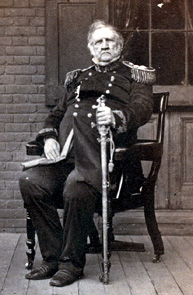|
Scott was born near Petersburg, Virginia. He studied
law until 1808, when he joined the United States Army and received
a commission as captain of light artillery. At the beginning
of the War of 1812 with Britain, Scott was appointed a lieutenant
colonel and sent to the Canadian frontier. He led his regiment
in the Battle of Queenston Heights on October 13, 1812, in which
the American forces were repulsed with heavy losses, and Scott
was taken prisoner. He was exchanged a year later. In 1814 Scott,
now a brigadier general, led his brigade in the battles of Chippewa,
on July 5, and Lundy's Lane on July 25. His military successes
made him a national hero, and he was promoted to major general.
In 1832 President Andrew Jackson appointed Scott military
guardian of federal authority during the nullification controversy
in South Carolina. Scott also oversaw the forced removal of the
Cherokee from Georgia to the Indian Territory of the West along
the "Trail of Tears." In 1841 Scott was appointed general-in-chief
of the U.S. Army, and in 1847, after the beginning of the Mexican
War, he was appointed commander of the U.S. forces in Mexico.
He led his troops in a series of victories, at Veracruz, Cerro
Gordo, and Chapultepec. On September 14, 1847, he occupied the
national palace in Mexico City. Scott returned to the United
States in 1848, and in 1852 Congress raised his rank to lieutenant
general, the first since George Washington. He was also nominated
by the Whig party for the presidency in 1852 but was overwhelmingly
defeated. |
![]()

